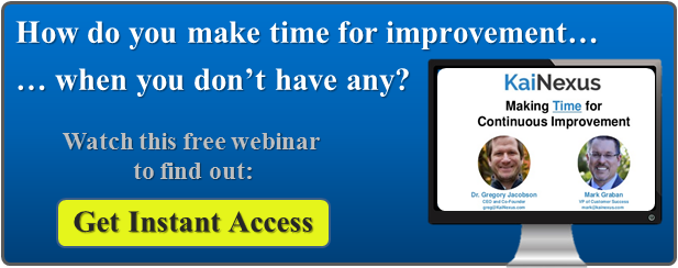 There are two things that really set the business methodology of Toyota Kata apart from the others. First is the focus on the process of improvement. Practitioners of Toyota Kata are as interested in how improvements are made as they are in the results of those improvements. In fact, the essence of “kata” is the routine of improvement.
There are two things that really set the business methodology of Toyota Kata apart from the others. First is the focus on the process of improvement. Practitioners of Toyota Kata are as interested in how improvements are made as they are in the results of those improvements. In fact, the essence of “kata” is the routine of improvement.
The second thing that makes Toyota Kata unique is its focus on coaching. In his bestselling book on the subject, Toyota Kata: Managing People for Improvement, Adaptiveness and Superior Results, Mike Rother proposes that it is not solutions themselves that provide sustained competitive advantage and long-term survival, but the degree to which an organization has mastered an effective routine for developing fitting solutions again and again, along unpredictable paths. This requires teaching the skills behind the solution.
Technology is a great asset to both pillars of Toyota Kata if it has the following essential features:
Improvement Identification
In order for an organization to develop effective routines for making small, useful changes to processes, it must have the chance to practice frequently. Toyota Kata software makes it easy for any employee to document an opportunity for improvement and begin the process of positive change. Because it is deployed widely in the organization and is a bottom-up solution, hundreds of opportunities can be identified and assessed.
Watch this video to see how KaiNexus helps this customer with Toyota Kata at every level:
Frictionless Workflow
The emphasis in Toyota Kata is on making one small change at a time so that the impact of that change can be evaluated and leaders can determine if that type of countermeasure should be more broadly deployed. This requires quick action when an opportunity is identified. Software solutions that have built-in notifications and alerts to keep improvement projects moving along swiftly support the development of kata.
Knowledge Repository
Toyota Kata is very much concerned with learning from past efforts. Practitioners repeat the improvement routines that have worked well before and abandon those that failed to achieve the desired results. Toyota Kata software collects information about each improvement effort in order to provide one source of data to drive future activities.
Kata Broadcasting
In the Toyota Kata methodology, it is every manager’s responsibility to make each team member better at identifying and acting upon opportunities for improvement. Software helps make this possible by broadcasting the results of each change that is made. Staff can learn from the experiences of others and make better decisions as they address new challenges.
Impact Assessment
When deciding which approaches to improvement should become standard, it is important to understand the impact they have on the organization in terms of cost savings, revenue generation, customer satisfaction and other key business metrics. Toyota Kata software should support this by tracking both the “hard” and “soft” results of improvement over time.
As Mike Rother puts it, “There are perhaps only three things we can and need to know with certainty: where we are, where we want to be, and by what means we should maneuver the unclear territory between here and there.” Toyota Kata software helps organizations figure out exactly that.



Add a Comment